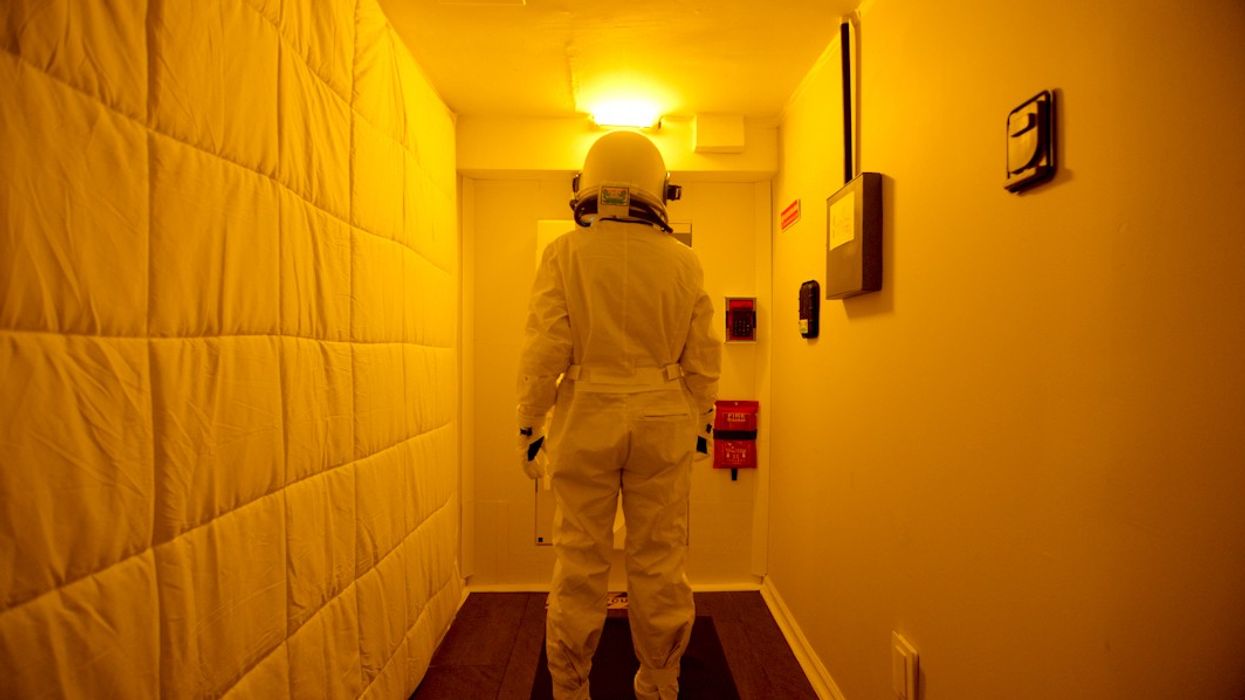How I Directed a Feature Film in My Basement
Writer/Director Chris Maes, on bringing the indie sci-fi thriller Hemisphere to the screen

Hemisphere
Written by Chris Maes
Like many others, I experienced a lot of anxiety during the COVID lockdown. Months spent inside the house, interacting with clients via Zoom calls—the whole thing of being stuck inside a space.
As I moved my work computer from my employer’s offices into my unused basement space (we have a fully finished basement) it struck me that I was standing in the middle of what could be a perfect movie soundstage.
As a kid, I enjoyed doing community theater. It was a welcome respite from dreaded schoolwork. I remember the stage flats, large sections of scenery propped up with clamps and sandbags. As I looked around the open basement space, I thought, "Why couldn’t I build the same flats here, and create rooms and environments to shoot a movie in?"

I own a decent selection of improvement equipment. With these tools, a sketchbook for making set designs, and cheap lumber, I began constructing the set for a space station movie. I decided we would only see 5 rooms: a bridge/kitchenette area, a crawlspace, an escape pod, the crew quarters where people sleep, and an airlock chamber. Concurrent with my set construction, I began writing a feature-length script.
It would be a full year before I had the completed feature film sitting on Premiere Pro. In that year, I went from completion of the shooting script to final delivery of the completed movie to my distributor.
I had endured Zoom casting sessions to find three great actors, rewrote the script to change the gender of the lead character from male to female, wrestled through 12 shoot days and several half-days, sought unsuccessfully to find an editor, and ultimately took on the editing myself. I found a talented composer, a great VFX artist, and dealt with sound design and color grade. Whew!

Here’s what I learned: Being a filmmaker is not for the faint of heart. You need to have the stomach to work through obstacles, all while maintaining relationships with loved ones. But it’s hugely rewarding. And, yes, you need a script with sharp dialogue, characters who evolve, and a structure.
But the journey only starts when you type fade out. Everything you do after that—and the fellow creatives and technicians you bring aboard—are working toward a singular goal of turning the script into a living, breathing thing that we call a movie. It’s a fun tightrope walk, navigating through the steps of the process.
Hemisphere taught me the value of rehearsing with actors inside the actual shooting set. And don’t underestimate the importance of pre-light days with your DP, establishing the look and specific lenses you’ll use before everyone is there.

The biggest benefit of all was that I own the location. That means every set, every room we’ve dressed and lit for shooting can remain that way until all the shooting is complete.
I’m fortunate to have had this experience, stemming from a wake-up call that happened one day during lockdown. My advice to other filmmakers considering their own feature directing experience is:
- Stay flexible. Roll with the punches, adapt, and move forward each day.
- Be willing to delegate (especially technical tasks like lighting, sound, and set dressing) to others.
- Cast your movie well—not with friends, but with professional actors. They will take your characters much further than you ever imagined. A great performance from an actor can save a scene.
- Be inspired by directors who came before you. You will be wrestling with the same problems they did or do. It’s a select group; enjoy being part of it.
Hemisphere is available to rent or own on Amazon Prime, Google Play, and Tubi.
For more information, check out @hemispheremovie on Instagram.
Chris Maes is a freelance writer/director/producer living outside Washington, D.C.
- Can Americans Make Movies in Cuba Now? ›
- Can Americans Make Movies in Cuba Now? ›
- Can Americans Make Movies in Cuba Now? ›
- OM SYSTEMS Goes Ultra Wide and Telephoto with Two MFT Lenses ›
- Support Your Local Cinema and See ‘The Terminator’ 4K Restoration for Art House Theater Day | No Film School ›











